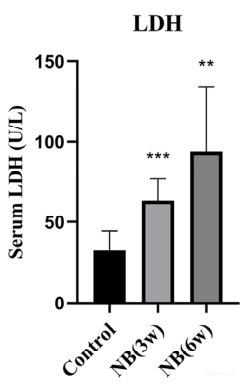Lactate Dehydrogenase (LDH) Activity Assay Kit (WST-8 method)
SKU: E-BC-K766-M-96
To better serve you, we would like to discuss your specific requirement.
Please Contact Us for a quote.
Lactate Dehydrogenase (LDH) Activity Assay Kit (WST-8 method)
| SKU # | E-BC-K766-M |
| Detection Instrument | Microplate reader (450 nm) |
| Detection method: | Colorimetric method |
Product Details
Properties
| Synonyms | LDH |
| Sample type | Serum, plasma, animal tissue, hydrothorax, cells, cell culture supernatant |
| Sensitivity | 0.11 U/L |
| Detection range | 0.11-39.9 U/L |
| Detection method |
Colorimetric method |
| Assay type | Enzyme Activity |
| Assay time | 30 min |
| Precision | Average inter-assay CV: 2.300% | Average intra-assay CV: 2.300% |
| Other instruments required | Microplate, Micropipettor, Vortex mixer, Water bath |
| Storage | -20℃ |
| Valid period | 12 months |
Images
Q Li et al investigate the hypoxia-induced neurogenic bladder fibrosis. Lactate dehydrogenase (LDH) activity of mouse and human serum was determined using LDH activity assay kit (E-BC-K766-M).

LDH activity in serum was significantly increased by NB. (**P<0.01, ***P<0.001)
Dilution of Sample
It is recommended to take 2~3 samples with expected large difference to do pre-experiment before formal experiment and dilute the sample according to the result of the pre-experiment and the detection range (0.11-39.9 U/L).
The recommended dilution factor for different samples is as follows (for reference only):
| Sample type | Dilution factor |
| Human serum | 10-20 |
| Dog serum | 10-20 |
| Mouse serum | 50-100 |
| Cynomolgus monkey serum | 10-20 |
| 10% Rat spleen tissue homogenate | 150-250 |
| 10% Rat liver tissue homogenate | 250-350 |
| 10% Rat kidney tissue homogenate | 250-350 |
| 10% Rat lung tissue homogenate | 250-350 |
Note: The diluent is reagent 1.
Detection Principle
Lactate dehydrogenase (LDH) is an oxidoreductase. LDH catalyzes the conversion of lactate to pyruvic acid and back, as it converts NAD+ to NADH and back. LDH is composed of four subunits (tetramer). The two most common subunits are the LDH-M and LDH-H protein. LDH is released into the blood by cells after tissue damage or erythrocyte hemolysis. Extracellular LDH activity is used to detect cell damage or cell death.
Kit Components & Storage
| Item | Component | Size 1(48 T) | Size 2(96 T) | Storage |
| Reagent 1 | Lysis Solution | 60 mL × 1 vial | 60 mL × 2 vials | -20℃, 12 months |
| Reagent 2 | Substrate | 1.5 mL ×1 vial | 1.5 mL × 2 vials | -20℃, 12 months |
| Reagent 3 | Chromogenic Agent | 1.5 mL ×1 vial | 1.5 mL × 2 vials | -20℃, 12 months, shading light |
| Reagent 4 | Coenzyme | Powder × 1 vial | Powder × 1 vial | -20℃, 12 months |
| Reagent 5 | Stop Solution | 3 mL ×1 vial | 6 mL ×1 vial | -20℃, 12 months |
| Reagent 6 | NADH Standard | Powder × 1 vial | Powder × 1 vial | -20℃, 12 months |
| Microplate | 96 wells | No requirement | ||
| Plate Sealer | 2 pieces | |||
Note: The reagents must be stored strictly according to the preservation conditions in the above table. The reagents in different kits cannot be mixed with each other. For a small volume of reagents, please centrifuge before use, so as not to obtain sufficient amount of reagents.
Technical Data:
Parameter:
Intra-assay Precision
Three human serum samples were assayed in replicates of 20 to determine precision within an assay (CV = Coefficient of Variation).
| Parameters | Sample 1 | Sample 2 | Sample 3 |
| Mean (U/L) | 2.60 | 18.50 | 26.00 |
| %CV | 2.6 | 2.3 | 2.0 |
Inter-assay Precision
Three human serum samples were assayed 20 times in duplicate by three operators to determine precision between assays.
| Parameters | Sample 1 | Sample 2 | Sample 3 |
| Mean (U/L) | 2.60 | 18.50 | 26.00 |
| %CV | 2.4 | 2.5 | 2.0 |
Sensitivity
The analytical sensitivity of the assay is 0.11 U/L. This was determined by adding two standard deviations to the mean O.D. obtained when the zero standard was assayed 20 times, and calculating the corresponding concentration.
Standard Curve
As the OD value of the standard curve may vary according to the conditions of the actual assay performance (e.g. operator, pipetting technique or temperature effects), so the standard curve and data are provided as below for reference only:
| Concentration (μmol/L) | 0 | 50 | 100 | 150 | 200 | 250 | 300 | 400 |
| Average OD | 0.054 | 0.171 | 0.292 | 0.430 | 0.559 | 0.691 | 0.845 | 1.114 |
| Absoluted OD | 0.000 | 0.117 | 0.238 | 0.377 | 0.505 | 0.638 | 0.792 | 1.061 |



